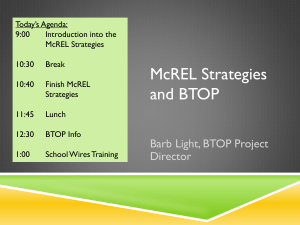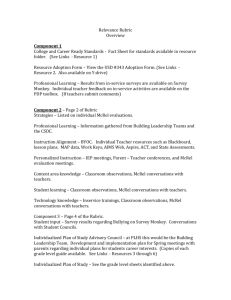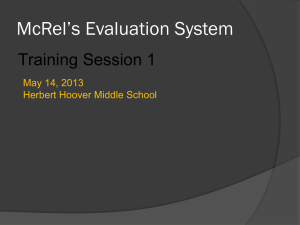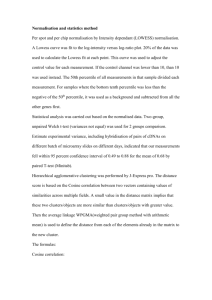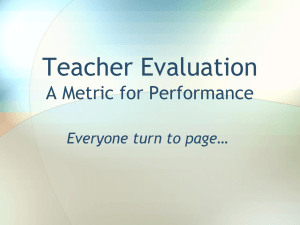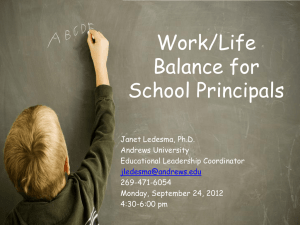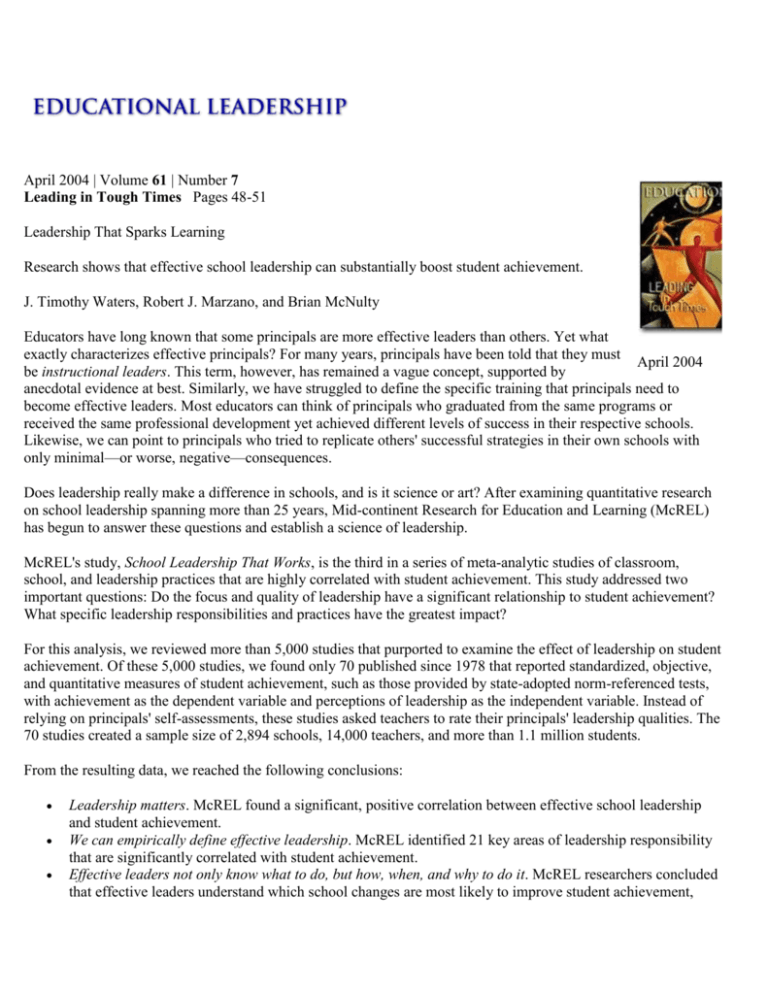
April 2004 | Volume 61 | Number 7
Leading in Tough Times Pages 48-51
Leadership That Sparks Learning
Research shows that effective school leadership can substantially boost student achievement.
J. Timothy Waters, Robert J. Marzano, and Brian McNulty
Educators have long known that some principals are more effective leaders than others. Yet what
exactly characterizes effective principals? For many years, principals have been told that they must
April 2004
be instructional leaders. This term, however, has remained a vague concept, supported by
anecdotal evidence at best. Similarly, we have struggled to define the specific training that principals need to
become effective leaders. Most educators can think of principals who graduated from the same programs or
received the same professional development yet achieved different levels of success in their respective schools.
Likewise, we can point to principals who tried to replicate others' successful strategies in their own schools with
only minimal—or worse, negative—consequences.
Does leadership really make a difference in schools, and is it science or art? After examining quantitative research
on school leadership spanning more than 25 years, Mid-continent Research for Education and Learning (McREL)
has begun to answer these questions and establish a science of leadership.
McREL's study, School Leadership That Works, is the third in a series of meta-analytic studies of classroom,
school, and leadership practices that are highly correlated with student achievement. This study addressed two
important questions: Do the focus and quality of leadership have a significant relationship to student achievement?
What specific leadership responsibilities and practices have the greatest impact?
For this analysis, we reviewed more than 5,000 studies that purported to examine the effect of leadership on student
achievement. Of these 5,000 studies, we found only 70 published since 1978 that reported standardized, objective,
and quantitative measures of student achievement, such as those provided by state-adopted norm-referenced tests,
with achievement as the dependent variable and perceptions of leadership as the independent variable. Instead of
relying on principals' self-assessments, these studies asked teachers to rate their principals' leadership qualities. The
70 studies created a sample size of 2,894 schools, 14,000 teachers, and more than 1.1 million students.
From the resulting data, we reached the following conclusions:
Leadership matters. McREL found a significant, positive correlation between effective school leadership
and student achievement.
We can empirically define effective leadership. McREL identified 21 key areas of leadership responsibility
that are significantly correlated with student achievement.
Effective leaders not only know what to do, but how, when, and why to do it. McREL researchers concluded
that effective leaders understand which school changes are most likely to improve student achievement,
what these changes imply for both staff and community, and how to tailor their leadership practices
accordingly.
Leadership Matters
The data from our meta-analysis demonstrate a substantial relationship between leadership and student
achievement. We found that the average effect size (expressed as a correlation) between leadership and student
achievement is .25, which means that as leadership improves, so does student achievement.
To interpret this correlation more precisely, consider two schools (school A and school B) with similar student and
teacher populations. Both demonstrate student achievement on a standardized, norm-referenced test at the 50th
percentile. Principals in both schools also are average—that is, their abilities in key leadership responsibilities rank
at the 50th percentile. Now assume that the principal of school B improves his or her demonstrated abilities in all
key responsibilities by exactly one standard deviation, meaning that these abilities now fall in the 84th percentile of
all principals rather than in the 50th percentile.
Our research findings indicate that this increase in leadership ability would translate into an expected mean student
achievement at school B that is 10 percentile points higher than mean achievement at school A. Expressed
differently, the studies taken as a whole suggest that improving principals' leadership abilities by one standard
deviation, from the 50th to the 84th percentile, would lead to an increase in average student achievement from the
50th to the 60th percentile—a substantial improvement.
Leadership Defined
So what is effective leadership? Our analysis of the 70 studies found that effective leadership comprises 21 key
areas of responsibility, all of which are positively correlated with higher levels of student achievement. Although
these responsibilities are interrelated, they have unique defining characteristics, and we report them as distinct
responsibilities.
Culture: fosters shared beliefs and a sense of community and cooperation.
Order: establishes a set of standard operating procedures and routines.
Discipline: protects teachers from issues and influences that would detract from their teaching time or
focus.
Resources: provides teachers with the materials and professional development necessary for the successful
execution of their jobs.
Curriculum, instruction, and assessment: is directly involved in the design and implementation of
curriculum, instruction, and assessment practices.
Knowledge of curriculum, instruction, and assessment: is knowledgeable about current practices.
Focus: establishes clear goals and keeps these goals at the forefront of the school's attention.
Visibility: has high-quality contact and interactions with teachers and students.
Contingent rewards: recognizes and rewards individual accomplishments.
Communication: establishes strong lines of communication with teachers and students.
Outreach: is an advocate and spokesperson for the school to all stakeholders.
Input: involves teachers in the design and implementation of important decisions and policies.
Affirmation: recognizes and celebrates school accomplishments and acknowledges failures.
Relationship: demonstrates empathy with teachers and staff on a personal level.
Change agent role: is willing and prepared to actively challenge the status quo.
Optimizer role: inspires and leads new and challenging innovations.
Ideals and beliefs: communicates and operates from strong ideals and beliefs about schooling.
Monitoring and evaluation: monitors the effectiveness of school practices and their impact on student
learning.
Flexibility: adapts his or her leadership behavior to the needs of the current situation and is comfortable
with dissent.
Situational awareness: is aware of the details and undercurrents in the running of the school and uses this
information to address current and potential problems.
Intellectual stimulation: ensures that faculty and staff are aware of the most current theories and practices in
education and makes the discussion of these practices integral to the school's culture.
The Differential Impact of Leadership
The correlation of .25 represents the average correlation between leadership and student achievement for all of the
70 studies that we examined. These studies reported a range of correlations, however; some were stronger and some
much weaker. More specifically, some studies reported the effect size for leadership and achievement as high as
.50, which translates mathematically into a one-standard-deviation difference in demonstrated leadership ability
correlating with a 19 percentile point increase in student achievement.
Other studies, however, reported that leaders who displayed the very same leadership qualities had only a
marginal—or worse, a negative—impact on student achievement. Specifically, some studies reported correlations
as low as -.02. This indicates that a one-standard-deviation improvement in leadership practices was correlated with
a 1 percentile point decrease in student achievement.
On the basis of extensive professional wisdom and a review of theoretical literature on leadership, we interpret this
data to mean that two primary variables determine whether leadership will have a positive or a negative impact on
student achievement. The first is the focus of change—whether or not leaders properly identify the correct focus for
school and classroom improvement efforts, those that are most likely to have a positive impact on student
achievement in their schools. The second variable is whether 1or not leaders properly understand the magnitude or
order of change that they are leading and adjust their leadership practices accordingly.
The Focus of Change
Harvard scholar Richard Elmore has noted that "knowing the right thing to do is the central problem of school
improvement" (2003, p. 9). Leaders can act like effective leaders, but if they fail to guide their schools toward
making the correct changes, these changes are likely to have a diminished or negative impact on student
achievement. We believe that the school and classroom practices we identified in our two previous meta-analytic
studies are, in fact, the "right things to do" in school improvement.
At the school level, these practices encompass a guaranteed and viable curriculum, challenging goals and effective
feedback, parent and community involvement, a safe and orderly environment, and collegiality and
professionalism. At the teacher level, they entail effective instructional strategies, classroom management, and
classroom curriculum design. At the student level, they entail a positive home environment, learned intelligence
and background knowledge, and motivation.
The Order of Change
Many educators can point to examples of leaders who knew the right things to do in one setting or with one
initiative but who were unable to replicate their successes in other settings or with other initiatives. The theoretical
literature on leadership, change, and the adoption of new ideas provides some insights into why this may occur.
Many theorists (Beckard & Pritchard, 1992; Bridges, 1991; Fullan, 1993; Heifetz, 1994; Hesslebein & Johnston,
2002; Nadler, Shaw, Walton, & Associates, 1994; Rogers, 1995) have made the case that not all changes are of the
same magnitude. Some changes have greater implications than others for staff members, students, parents, and
other stakeholders. Different labels have been used to differentiate between magnitudes of change: technical versus
adaptive, incremental versus fundamental, and continuous versus discontinuous, for example. We use the terms
first-order changes and second-order changes to make this distinction.
First-order changes build on past and existing models. They are consistent with stakeholders' prevailing values and
norms and can be implemented largely with existing knowledge and skills—and with help from outside experts. In
short, they merely tinker at the edges and don't seek to change the core values, beliefs, or structures of the school.
Second-order changes, on the other hand, dramatically break with the past and challenge existing models, norms,
and values. As a result, they cannot be implemented by outside experts. Stakeholders must find their way through
the changes together, acquiring along the way new sets of knowledge, skills, ways of thinking, and, often, values.
Order of change has less to do with the change itself than with how stakeholders view the change. They may find
the change consistent with existing values and norms, be able to implement the change with existing knowledge
and resources, and agree on the changes needed and the procedure for implementing them. These are first-order
changes. In an education context, these might be new classroom instruction practices, curricular programs, or data
collection and reporting systems that build on established patterns and use existing knowledge.
The same changes, however, may represent different orders of change for different individuals or stakeholder
groups. What some will experience as a first-order change others may experience as a second-order change. For
example, some educators, policymakers, and parents may view the implementations of standards, high-stakes
testing, and accountability measures as first-order changes, as an appropriate response—consistent with their
prevailing values and norms—to problems in schools. Others see these changes as dramatic and undesirable breaks
with the past. For these individuals, the "solution" of standards, testing, and accountability is, in fact, a problem.
Thus, for these stakeholders, such changes are second-order.
If leaders fail to understand or acknowledge that some changes are second-order for some or all of their
stakeholders, they may struggle to get support for the successful implementation of these changes. As a result, their
initiatives may fail to improve student achievement.
To more clearly illustrate second-order changes, imagine a school implementing some of the changes required by
the No Child Left Behind Act. One key provision of the law requires schools to disaggregate their data by student
subgroups and find ways to ensure that all subgroups demonstrate proficiency on the state test. At first blush,
simply reporting disaggregated data may seem to be a rather incremental change, a minor modification to existing
assessment systems. Yet this seemingly simple change could cause tremendous ripples among school staff and
community members. Reporting these data and demonstrating ways in which schools have not adequately served
all students could challenge some stakeholders' deeply held norms and values. Some teachers and parents may hold
a sink-or-swim philosophy of schooling that sees the main purpose of schools as sorting and selecting students
according to ability. These individuals may question why the school is devoting additional resources to help
struggling students improve achievement—or question whether doing so will have any real impact.
Achieving the goals of the No Child Left Behind Act will undoubtedly require schools to undertake numerous
changes, many of which may challenge prevailing norms and values and require educators to acquire new
knowledge and skills. Successfully implementing these second-order changes requires effective leadership.
It has been said that if you want to change the world, start by looking in the mirror. Given the strong correlation
that we have found between leadership and student achievement, the same notion may apply to leaders who want to
change their schools. Our research on school leadership, with its quantitative data defining the traits of effective
leaders, may be just the mirror that leaders need.
References
Beckard, R., & Pritchard, W. (1992). Changing the essence: The art of creating and leading fundamental change in
organizations. San Francisco: Jossey-Bass.
Bridges, W. (1991). Managing transitions: Making the most of change. Reading, MA: Addison-Wesley.
Elmore, R. (2003). Knowing the right thing to do: School improvement and performance-based accountability.
Washington, DC: NGA Center for Best Practices.
Fullan, M. G. (1993). Change forces: Probing the depths of educational reform. Bristol, PA: Falmer Press.
Heifetz, R. (1994). Leadership without easy answers. Cambridge, MA: Belknap Press.
Hesselbein, F., & Johnston, R. (Eds.). (2002). On leading change: A leader to leader guide. San Francisco: JosseyBass.
Nadler, D. A., Shaw, R. B., Walton, A. E., & Associates. (1994). Discontinuous change. San Francisco: JosseyBass.
Rogers, E. (1995). Diffusion of innovations. New York: The Free Press.
Authors' note: Two McREL research reports are available online: A Theory-Based Meta-Analysis of Research on
Instruction can be downloaded at www.mcrel.org/PDF/Instruction/5982RR_InstructionMeta_Analysis.pdf; A New
Era of School Reform is available at
www.mcrel.org/PDF/SchoolImprovementReform/5002RR_NewEraSchoolReform.pdf.
J. Timothy Waterys (twaters@mcrel.org) is Executive Director, Robert J. Marzano (rmarzano@mcrel.org) is
Senior Scholar, and Brian McNulty (bmcnulty@mcrel.org) is Vice President of Field Services at Mid-continent
Research for Education and Learning in Aurora, Colorado.
Copyright © 2004 by Association for Supervision and Curriculum Development
Association for Supervision and Curriculum Development (ASCD)
1703 N. Beauregard Street, Alexandria, VA 22311 USA • 1-800-933-2723 • 1-703-578-9600
Copyright © ASCD, All Rights Reserved • Privacy Statement

